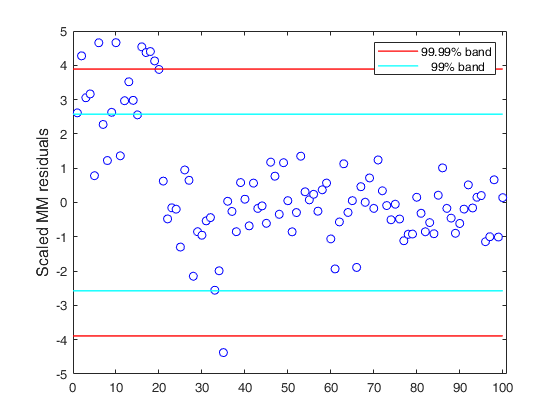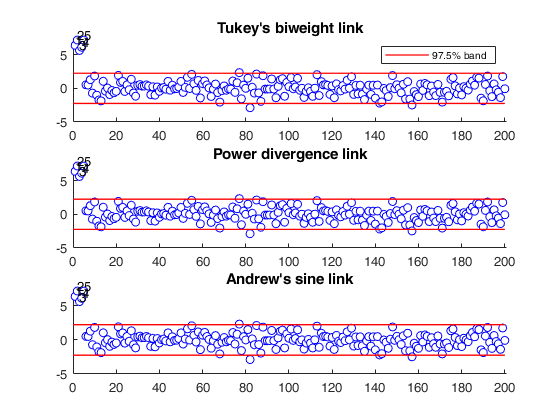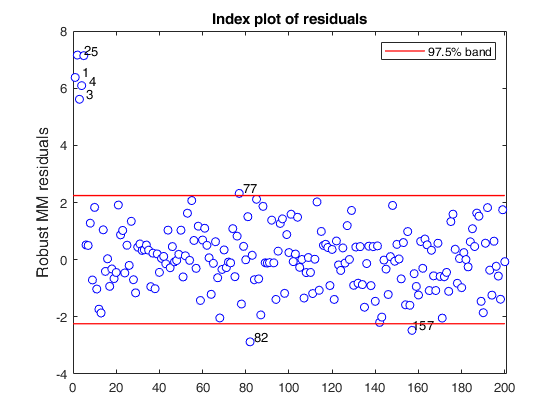MMreg
MMreg computes MM estimator of regression coefficients
Description
Examples
MMreg with all default options.
Run this code to see the output shown in the help file
n=200;
p=3;
randn('state', 123456);
X=randn(n,p);
% Uncontaminated data
y=randn(n,1);
% Contaminated data
ycont=y;
ycont(1:5)=ycont(1:5)+6;
[out]=MMreg(ycont,X);
MMreg with optional input arguments.
MMreg using the hyperbolic rho function.
% Run this code to see the output shown in the help file.
n=200;
p=3;
randn('state', 123456);
X=randn(n,p);
% Uncontaminated data
y=randn(n,1);
% Contaminated data
ycont=y;
ycont(1:5)=ycont(1:5)+6;
[out]=MMreg(ycont,X,'Srhofunc','optimal');
MMreg with optional input arguments.
MMreg using the OLS estimates ac InitialEst.
% Run this code to see the output shown in the help file.
n=200;
p=3;
randn('state', 123456);
X=randn(n,p);
% Uncontaminated data
y=randn(n,1);
% Contaminated data
ycont=y;
ycont(1:5)=ycont(1:5)+6;
% OLS estimates
bols=[ones(n,1) X]\y;
res=y-[ones(n,1) X]*bols;
sols=sqrt((res'*res)/(n-p-1));
InitialEst.beta=bols;
InitialEst.scale=sols;
[out]=MMreg(ycont,X,'InitialEst',InitialEst);
Related Examples
 Comparing the output of different MMreg runs.
Comparing the output of different MMreg runs.
 Comparing the output of different MMreg runs.
Comparing the output of different MMreg runs.
state=100;
randn('state', state);
n=100;
X=randn(n,3);
bet=[3;4;5];
y=3*randn(n,1)+X*bet;
y(1:20)=y(1:20)+13;
%For outlier detection we consider both the nominal individual 1%
%significance level and the simultaneous Bonferroni confidence level.
% Define nominal confidence level
conflev=[0.99,1-0.01/length(y)];
% Define number of subsets
nsamp=3000;
% Define the main title of the plots
titl='';
% MM estimators
[outMM]=MMreg(y,X,'conflev',conflev(1));
laby='Scaled MM residuals';
resindexplot(outMM.residuals,'title',titl,'laby',laby,'numlab','','conflev',conflev)
% In this example, MM estimator seems to detect half of the outlier with a Bonferroni significance level.
% By simply changing the seed to 543 (state=543), using a Bonferroni size
%of 1%, no unit is declared as outlier and just half of them using the 99%
%band.
Total estimated time to complete S estimate: 1.17 seconds

Comparison between direct call to MMreg and call to Sreg and MMregcore.
n=30;
p=3;
randn('state', 123456);
X=randn(n,p);
% Uncontaminated data
y=randn(n,1);
% Contaminated data
ycont=y;
ycont(1:5)=ycont(1:5)+6;
% Two different rho functions are used for S and MM
rhofuncS='hyperbolic';
rhofuncMM='hampel';
% Direct call to MMreg
[out]=MMreg(ycont,X,'Srhofunc',rhofuncS,'rhofunc',rhofuncMM,'Snsamp',0);
% Call to Sreg and then to MMregcore
[outS]=Sreg(ycont,X,'rhofunc',rhofuncS,'nsamp',0);
outMM=MMregcore(ycont,X,outS.beta,outS.scale,'rhofunc',rhofuncMM);
disp('Difference between direct call to S and the calls to Sreg and MMregcore')
max(abs([out.beta-outMM.beta]))
 Comparison of TB, PD and Andrew's sine estimator.
Comparison of TB, PD and Andrew's sine estimator.
 Comparison of TB, PD and Andrew's sine estimator.
Comparison of TB, PD and Andrew's sine estimator.
close all
n=200;
p=3;
rng('default')
rng(100);
X=randn(n,p);
% Uncontaminated data
y=randn(n,1);
% Contaminated data
ycont=y;
ycont(1:5)=ycont(1:5)+6;
close all
h1=subplot(3,1,1);
% TB is used both in the S and in MM step.
[outTB]=MMreg(ycont,X,'plots',0);
resindexplot(outTB,'h',h1)
title('Tukey''s biweight link')
% mdpd is used both in the S and in MM step.
[outmdpd]=MMreg(ycont,X,'Srhofunc','mdpd','rhofunc','mdpd','plots',0);
h2=subplot(3,1,2);
resindexplot(outmdpd,'h',h2)
title('Power divergence link')
% AS is used both in the S and in MM step.
[outAS]=MMreg(ycont,X,'Srhofunc','AS','rhofunc','AS','plots',0);
h3=subplot(3,1,3);
resindexplot(outAS,'h',h3)
title('Andrew''s sine link')
Total estimated time to complete S estimate: 1.25 seconds Total estimated time to complete S estimate: 0.24 seconds Total estimated time to complete S estimate: 0.54 seconds

Input Arguments
y — Response variable.
Vector.
A vector with n elements that contains the response variable. y can be either a row or a column vector.
Data Types: single| double
X — Data matrix of explanatory variables (also called 'regressors') of
dimension (n x p-1).
Rows of X represent observations, and columns
represent variables.
Missing values (NaN's) and infinite values (Inf's) are allowed, since observations (rows) with missing or infinite values will automatically be excluded from the computations.
Data Types: single| double
Name-Value Pair Arguments
Specify optional comma-separated pairs of Name,Value arguments.
Name is the argument name and Value
is the corresponding value. Name must appear
inside single quotes (' ').
You can specify several name and value pair arguments in any order as
Name1,Value1,...,NameN,ValueN.
'conflev',0.99
, 'eff',0.99
, 'effshape',1
, 'InitialEst',[]
, 'intercept',false
, 'nocheck',true
, 'refsteps',10
, 'rhofunc','optimal'
, 'rhofuncparam',5
, 'Snsamp',1000
, 'tol',1e-10
, 'yxsave',1
, 'plots',0
conflev
—Confidence level which is
used to declare units as outliers.scalar.
Usually conflev=0.95, 0.975 0.99 (individual alpha) or 1-0.05/n, 1-0.025/n, 1-0.01/n (simultaneous alpha).
Default value is 0.975
Example: 'conflev',0.99
Data Types: double
eff
—nominal efficiency.scalar.
Scalar defining nominal efficiency (i.e. a number between 0.5 and 0.99). The default value is 0.95.
Asymptotic nominal efficiency is:
Example: 'eff',0.99
Data Types: double
effshape
—location or scale efficiency.dummy scalar.
If effshape=1 efficiency refers to shape efficiency, else (default) efficiency refers to location.
Example: 'effshape',1
Data Types: double
InitialEst
—starting values of the MM-estimator.[] (default) | structure.
InitialEst must contain the following fields
| Value | Description |
|---|---|
beta |
v x 1 vector (estimate of the initial regression coefficients) |
scale |
scalar (estimate of the scale parameter). If InitialEst is empty (default) or InitialEst.beta contains NaN values, program uses S estimators. In this last case, it is possible to specify the options given in function Sreg. |
Example: 'InitialEst',[]
Data Types: struct or empty value
intercept
—Indicator for constant term.true (default) | false.
Indicator for the constant term (intercept) in the fit, specified as the comma-separated pair consisting of 'Intercept' and either true to include or false to remove the constant term from the model.
Example: 'intercept',false
Data Types: boolean
nocheck
—Check input arguments.boolean.
If nocheck is equal to true, no check is performed on matrix y and matrix X. Notice that y and X are left unchanged. In other words, the additional column of ones for the intercept is not added.
As default nocheck=false.
Example: 'nocheck',true
Data Types: boolean
refsteps
—Maximum iterations.scalar.
Scalar defining maximum number of iterations in the MM loop. Default value is 100.
Example: 'refsteps',10
Data Types: double
rhofunc
—rho function.string.
String which specifies the rho function which must be used to weight the residuals.
Possible values are: 'bisquare';
'optimal';
'hyperbolic';
'hampel';
'mdpd'.
'AS'.
'bisquare' uses Tukey's \rho and \psi functions.
See TBrho and TBpsi.
'optimal' uses optimal \rho and \psi functions.
See OPTrho and OPTpsi.
'hyperbolic' uses hyperbolic \rho and \psi functions.
See HYPrho and HYPpsi.
'hampel' uses Hampel \rho and \psi functions.
See HArho and HApsi.
'mdpd' uses Minimum Density Power Divergence \rho and \psi functions.
'AS' uses Andrew's sine \rho and \psi functions.
The default is bisquare
Example: 'rhofunc','optimal'
Data Types: char
rhofuncparam
—Additional parameters for the specified rho function.scalar | vector.
For hyperbolic rho function it is possible to set up the value of k = sup CVC (the default value of k is 4.5).
For Hampel rho function it is possible to define parameters a, b and c (the default values are a=2, b=4, c=8).
Example: 'rhofuncparam',5
Data Types: single | double
Soptions
—options to pass to Sreg for initial S estimator.name value pairs.
Options if initial estimator is S and InitialEst is empty.
The options are: Smsg, Snsamp,Srefsteps,Srefstepsbestr, Srhofunc, Srhofuncparam, Sreftol, Sreftolbestr, Sminsctol, Sbestr.
See function Sreg for more details on these options.
It is necessary to add to the S options the letter S at the beginning. For example, if you want to use the optimal rho function, the supplied option is 'Srhofunc','optimal'. For example, if you want to use 3000 subsets, the supplied option is 'Snsamp',3000.
Example: 'Snsamp',1000
Data Types: single | double
tol
—Tolerance.scalar.
Scalar controlling tolerance in the MM loop.
Default value is 1e-7.
Example: 'tol',1e-10
Data Types: double
yxsave
—the response vector y and data matrix X are saved into the output
structure out.scalar.
Default is 0, i.e. no saving is done.
Example: 'yxsave',1
Data Types: double
plots
—Plot on the screen.scalar | structure.
If plots = 1, generates a plot with the robust residuals against index number. The confidence level used to draw the confidence bands for the residuals is given by the input option conflev. If conflev is not specified, a nominal 0.975 confidence interval will be used.
Example: 'plots',0
Data Types: single | double
Output Arguments
out — description
Structure
A structure containing the following fields:
| Value | Description |
|---|---|
beta |
p x 1 vector containing MM estimate of regression coefficients. |
auxscale |
scalar, S estimate of the scale (or supplied external estimate of scale, if option InitialEst is not empty). |
residuals |
n x 1 vector containing standardized MM residuals. |
fittedvalues |
n x 1 vector containing the fitted values. out.residuals=(y-X*out.beta)/out.auxscale |
weights |
n x 1 vector. Weights assigned to each observation. |
Sbeta |
p x 1 vector containing S estimate of regression coefficients (or supplied initial external estimate of regression coefficients, if option InitialEst is not empty). |
Ssingsub |
Number of subsets without full rank in the S preliminary part. Notice that out.singsub > 0.1*(number of subsamples) produces a warning. |
outliers |
1 x k vectors containing the outliers which have been found. |
conflev |
Confidence level that was used to declare outliers. |
rhofuncS |
string identifying the rho function which has been used in the S initial step. This field is empty if input option InitialEst is not empty. |
rhofuncparamS |
vector which contains the additional parameters for the specified rho function which have been used in the S initial step. This field is empty if input option InitialEst is not empty. |
rhofunc |
string identifying the rho function which has been used in the MM loop. |
rhofuncparam |
vector which contains the additional parameters for the specified rho function which have been used in the MM loop. |
y |
response vector Y. The field is present only if option yxsave is set to 1. |
X |
data matrix X. The field is present only if option yxsave is set to 1. |
class |
'MMreg' |
References
Maronna, R.A., Martin D. and Yohai V.J. (2006), "Robust Statistics, Theory and Methods", Wiley, New York.
Acknowledgements
This function follows the lines of MATLAB/R code developed during the years by many authors.
For more details see the R library robustbase http://robustbase.r-forge.r-project.org/ The core of these routines, e.g. the resampling approach, however, has been completely redesigned, with considerable increase of the computational performance.
See Also

|
MMmulteda |
MMregcore |
 |
|
|
Functions |
|
• The developers of the toolbox • The forward search group • Terms of Use • Acknowledgments
